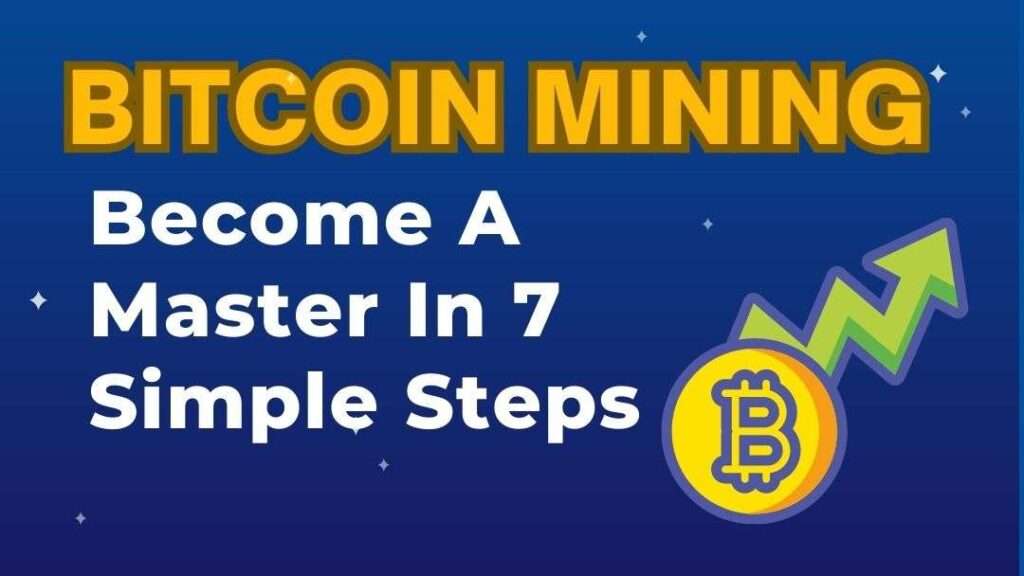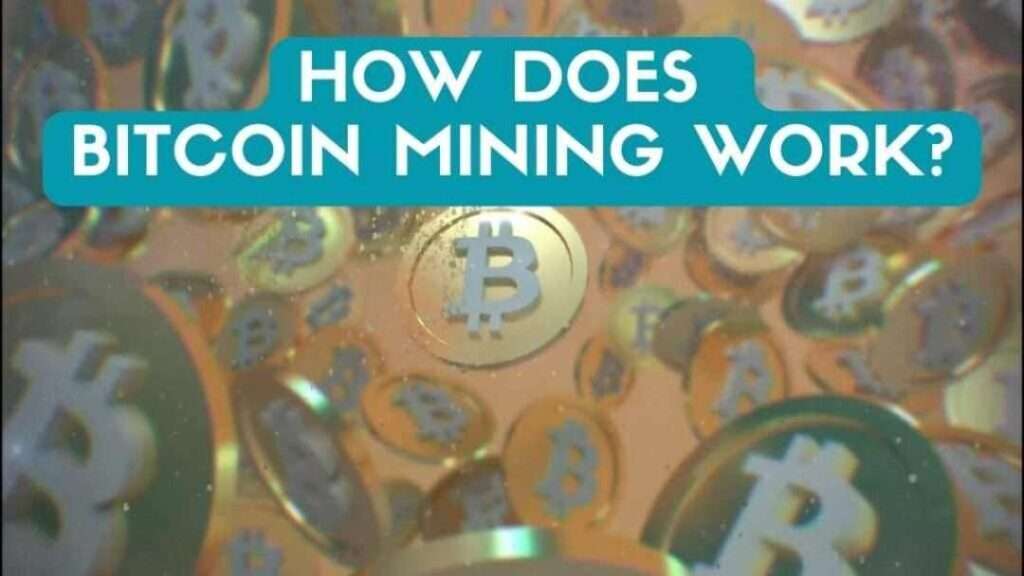{ bitcoin mining, bitcoin mining in 7 steps, how does bitcoin mining work, what is bitcoin mining, how to Become a Successful Miner}
Are you willing to start an exciting journey into the fascinating world of Bitcoin mining?
It is understandable why many individuals are confused when they hear the term “Bitcoin miner.” So do not worry!
This comprehensive guide on Bitcoin mining will arm you with the information and abilities required to master the craft if you ever wish to become a seasoned mining specialist. In this captivating article, we will delve into the depths of this fascinating topic, exploring the wonders of Bitcoin mining in 7 steps.

You’ll get to know What exactly is Bitcoin Mining? How does it work its magic? And most importantly, how can you become a successful miner yourself? Bitcoin, my friends, reigns supreme as the most popular cryptocurrency, boasting a colossal market capitalization. Just like any other financial arena, the cryptocurrency market can be quite volatile. But fear not, for armed with the right knowledge, you can navigate these treacherous waters and emerge victorious in the world of crypto. Now, let us embark on this thrilling journey together!
What is Bitcoin Mining?
Bitcoin mining is an intriguing process that involves the introduction of new bitcoins into circulation. It operates on a vast network of computers worldwide, all running specialized Bitcoin code.
This network is critical in validating transactions and accurately recording them in the blockchain, which serves as the cryptocurrency’s decentralized ledger. Bitcoin mining protects the integrity and security of the digital currency system by utilizing the power of this network.
It is the kind of network that verifies new transactions or exchanges. It is a fundamental part of the maintenance and development of the blockchain ledger, so in simple words, we can understand that mining is the medium of circulation of new bitcoins that enter the market. “Mining” is done using fantastic hardware that solves very complex computational and numerical problems.“Bitcoin mining is what makes the Bitcoin network secure,” says Stephen Ristiq, a know-it-all.
In other words, we can say that this is accomplished by incredibly expensive and powerful computers whose sole function is to run algorithms to solve a mathematical problem that allows their owner to obtain a Bitcoin block and revenue. Due to the magnetic appeal of Mining many investors interested in cryptocurrency, as miners receive rewards for their work with crypto tokens.
The “Bitcoin reward bestowed upon miners serves as a compelling incentive that drives individuals to actively participate in the fundamental mission of mining. This mission revolves around the vital tasks of validating and overseeing Bitcoin transactions to ensure their authenticity and integrity. What makes Bitcoin truly fascinating is the fact that these responsibilities are distributed among countless users across the globe. Bitcoin stands out as a cryptocurrency that flourishes on a peer-to-peer network where regulation is upheld collectively rather than by a single governing agency due to its decentralized character, which excludes any dependence on a central authority like a central bank or government.

How Does Bitcoin Mining Work?
Ever wondered about the whole shebang behind Bitcoin mining? It’s totally normal to feel a little puzzled. Questions start popping up in our minds like, how does this thing even work? And how can we jump into the action?
Here’s the scoop: Bitcoin mining involves confirming and verifying transactions on those fancy Bitcoin exchanges and recording them onto the blockchain. Sounds simple, right? Well, not quite. It’s like cracking complex codes and solving tricky algorithms.
This mining business is an essential piece of the puzzle called Bitcoin’s “Proof of Work” consensus mechanism. The goal? Adding a fresh block to the chain approximately every 10 minutes. So, how do miners earn their precious Bitcoins in this process? Let’s break it down, as explained by Bruce Fenton, CEO extraordinaire of a fintech company. Miners have a shot at earning some shiny Bitcoins every 10 minutes, and the amount depends on the computing power they bring to the table. The more power, the better the odds.
But hold on, mining has come a long way, my friend. In recent years, it has gone through some serious upgrades and is constantly evolving. The latest gizmos in the mining realm are these snazzy machines called application-specific integrated circuits, or ASICs for short. These babies are designed specifically to handle all the computational might needed for mining Bitcoins.
Now, let’s talk about something called a Bitcoin hash. It’s basically a measure of the mining muscle flexed on the network to process transactions. According to the mighty CEO Rob Chang, the latest generation of these dedicated mining rigs can churn out potential solutions to those block equations at an eye-popping rate of around 100 trillion hashes per second. That’s some serious horsepower!
Mastering Bitcoin Mining: Your Ultimate Guide on How to Become a Successful Miner
Now, we’ll walk you through the process step by step, optimize your operations, and assist you in managing the ever-changing cryptocurrency landscape. Let’s embark on this exciting journey together!

Step 1: Understanding Bitcoin Mining and Blockchain Technology
To truly grasp the essence of Bitcoin mining, it’s vital to comprehend the underlying technology that powers it. In this step, we will delve into the fundamentals of blockchain technology, decentralized consensus, and the role of miners in verifying transactions. By studying the content of top-ranking competitors, we can identify common recurring phrases and essential aspects of Bitcoin mining to provide you with a comprehensive understanding.
The Basics of Blockchain Technology
Imagine a public ledger that records every transaction in real time. That’s what blockchain is all about. Each transaction is a “block” added to a chain of previous transactions. This chain is distributed across multiple computers, making it nearly impossible to tamper with. Miners validate transactions, ensuring they are legitimate and adding them to the blockchain.
Example: Let’s say Mr. X wants to send Mr. Y 1 Bitcoin. Miners verify this transaction by solving complex mathematical puzzles, confirming its authenticity, and adding it to the blockchain. This decentralized verification process ensures transparency and security.
Step 2: Setting Up Your Mining Hardware and Software
To start mining, you’ll need the right hardware and software. Let’s explore the essentials to get you up and running.
Hardware Requirements
Bitcoin mining requires specialized hardware called ASICs (Application-Specific Integrated Circuits). These powerful machines are designed solely for mining cryptocurrencies, providing maximum efficiency and performance.
Example: Popular ASIC models include Bitmain Antminer and MicroBT Whatsminer. These devices are specifically engineered to solve complex algorithms quickly, increasing your chances of mining a Bitcoin block.
Mining Software
When you have got your hardware ready now, it’s time to dive into the exciting task of selecting the perfect mining software. This decision is crucial as it will connect your hardware to the expansive Bitcoin network, allowing you to actively participate in the thrilling mining process. Think of the software as the magical bridge that links your equipment with the network, enabling smooth communication and ensuring you can make your mark in the mining community.
By choosing the right software, you’ll be ready to embark on your mining adventure with confidence and start reaping the well-deserved rewards for your efforts. So let’s get ready to explore the options and find the perfect mining software to fuel your journey to success!
Example: Some popular mining software options include CGMiner, BFGMiner, and EasyMiner. These user-friendly applications enable you to configure your mining settings, monitor your hardware’s performance, and connect to mining pools.
Step 3: Joining a Mining Pool
Joining a mining pool is an excellent way to increase your chances of earning consistent rewards. Let’s explore how mining pools work and how to choose the right one.
Understanding Mining Pools
Mining pools bring together multiple miners who combine their computational power to mine collectively. This collaborative approach improves the odds of mining a Bitcoin block and receiving a proportional share of the rewards.
Example: Imagine you’re part of a mining pool with 100 participants. Instead of competing against each other, you work together to solve algorithms. If the pool successfully mines a block, the rewards are distributed among all members based on their contributions.
Selecting the Right Mining Pool
Choosing the right mining pool is essential for optimal results. Consider factors such as pool fees, payout frequency, and the pool’s reputation before making your decision.
Example: Popular mining pools include F2Pool, Poolin, and Slush Pool. Research each pool’s track record, reliability, and overall performance to find one that aligns with your goals.
Step 4: Understanding the Mining Process and Solving Hash Functions
Mining Bitcoins involves solving complex mathematical puzzles known as hash functions. Let’s dive into the mining process and explore how miners validate transactions.
Mining Process Overview
As a miner, your role is to validate transactions and secure the Bitcoin network. You accomplish this by solving cryptographic puzzles that require significant computational power.
Example: Miners use their hardware to perform countless calculations, searching for a specific solution to the puzzle. The first miner to find the solution gets to add a block of verified transactions to the blockchain and receives a reward in Bitcoins.
Solving Hash Functions
Hash functions are mathematical algorithms that miners need to solve to validate transactions. These functions generate unique outputs (hashes) based on the input data.
Example: Miners input transaction data into the hash function, which produces a hash. The goal is to find a hash that meets specific criteria defined by the network. Miners continually adjust their calculations until they find a hash that meets the required criteria, earning the right to add a block to the blockchain.

Step 5: Managing Mining Operations and Maximizing Efficiency
Efficiency plays a vital role in successful Bitcoin mining. In this step, we’ll cover essential strategies to optimize your mining operations and enhance profitability. We’ll discuss energy-saving techniques, effective cooling solutions for your mining hardware, and the significance of selecting the most suitable mining pool. Additionally, we’ll delve into mining profitability factors such as network difficulty, block rewards, and transaction fees.
Energy-Saving Techniques
Reducing energy consumption is a key factor in maximizing mining profitability. Consider strategies such as optimizing hardware settings, implementing power-saving modes, and exploring renewable energy options.
Example: Investing in energy-efficient hardware and setting up your mining rig in a cool, well-ventilated area can significantly reduce energy costs. Additionally, exploring renewable energy sources, such as solar or wind power, can make your mining operations more environmentally friendly.
Cooling Solutions
Mining generates significant heat, which can affect your hardware’s performance. Implementing effective cooling solutions, such as fans or liquid cooling systems, helps maintain optimal operating temperatures and prolongs the lifespan of your equipment.
Example: Installing powerful fans or utilizing liquid cooling systems can dissipate heat effectively, preventing your hardware from overheating and ensuring consistent performance.
Choosing the Right Mining Pool
Selecting the right mining pool can impact your overall mining efficiency and profitability. Consider factors such as pool fees, payout frequency, and the pool’s hash rate to make an informed decision.
Example: A mining pool with a higher hash rate typically offers a higher chance of successfully mining blocks. However, keep in mind that larger pools may distribute rewards among more participants.
Step 6: Ensuring Security and Protecting Your Mining Rewards
As a Bitcoin miner, it’s crucial to prioritize security and protect your hard-earned mining rewards. We’ll guide you through best practices for securing your mining operations, including setting up secure wallets for storing your Bitcoins and implementing robust security measures to safeguard against hacking attempts and other threats.
Setting Up Secure Wallets
Securing your mining rewards begins with setting up a secure wallet to store your Bitcoins. Consider using a hardware wallet or a software wallet with strong encryption to ensure the safety of your digital assets.
Example: Hardware wallets, such as Ledger or Trezor, provide offline storage and an extra layer of protection against online threats. Software wallets like Electrum or Exodus offer convenient access to your Bitcoins while still prioritizing security.
Implementing Robust Security Measures
Protecting your mining operations requires implementing robust security measures. These may include utilizing two-factor authentication, regularly updating your mining software, and practicing safe browsing habits to avoid phishing attacks.
Example: Enabling two-factor authentication adds an extra layer of security by requiring a secondary verification method, such as a unique code generated on your smartphone, to access your mining accounts. Regularly updating your mining software ensures you have the latest security patches and bug fixes.
Step 7: Staying Informed and Adapting to the Evolving Landscape
The world of Bitcoin mining is constantly evolving, with new developments and advancements shaping the industry. In this final step, we’ll emphasize the importance of staying informed about the latest trends, regulations, and technological advancements in Bitcoin mining. We’ll provide resources for staying up-to-date and offer tips on how to adapt your mining strategies to remain competitive in this dynamic landscape.
Continuous Learning and Research
To thrive as a Bitcoin miner, continuous learning and research are crucial. Stay updated on the latest mining techniques, hardware advancements, and industry news. Engage in online communities and forums to learn from experienced miners and share insights.
Example: Subscribe to reputable cryptocurrency news sources, follow influential figures in the industry on social media platforms, and join mining-focused forums like Bitcointalk or Reddit’s r/BitcoinMining. These resources can provide valuable insights and keep you informed about emerging trends.
Adapting to Changing Circumstances
Flexibility and adaptability are key traits of successful Bitcoin miners. The mining landscape is subject to changes in network difficulty, mining rewards, and market conditions. Adapt your strategies accordingly to maximize your profitability and stay ahead of the competition.
Example: Regularly evaluate your mining operations, adjust your hardware settings, and consider exploring alternative mining algorithms or cryptocurrencies when it becomes more profitable to do so. Stay agile to capitalize on new opportunities that arise in the ever-changing cryptocurrency market.
Conclusions
Congratulations! You’ve mastered the essentials of Bitcoin mining. Bravo! By delving into the intricacies of this fascinating technology, setting up your hardware and software like a pro, joining a mining pool to maximize your potential, and gaining a deep understanding of the mining process itself, you’re on the fast track to becoming a bona fide mining success story.
But here’s the secret: The world of cryptocurrencies is an ever-evolving landscape, and to stay ahead of the game, you must remain endlessly curious. Embrace the winds of change, my friend! Continuously update your knowledge, explore innovative mining techniques, and tap into valuable resources to optimize your operations. Adaptation is the name of the game.

With your dedication, unwavering perseverance, and a rock-solid grasp of Bitcoin mining, you’re about to embark on an extraordinary journey. Brace yourself, for the potential of this revolutionary technology is vast and boundless. We’ve taken you through the ins and outs of Bitcoin mining in three comprehensive steps. This article has provided you with a remarkable overview of what Bitcoin is, how it operates, and, most importantly, how to mine it.
Now, here’s the secret sauce: Revisit this article time and again. Let its wisdom seep into your core. Understand it in every fiber of your being. For the future is calling, and it’s beckoning you to embrace the world of cryptocurrencies and Bitcoin. Get ready, my friend, because a new era is dawning, and you’re primed to seize its opportunities. So, let’s dive in, absorb the knowledge, and be prepared to conquer the exciting world that lies ahead—a world brimming with cryptocurrency and the mighty Bitcoin.
Frequently Asked Questions ( FAQs)
What Does Mining for Bitcoin Mean?
Mining for Bitcoin involves using specialized hardware and software to solve complex mathematical problems. Miners compete with each other to find a solution to these problems, and the first miner to solve it successfully adds a new block of transactions to the blockchain. In return for their efforts, miners are rewarded with newly created Bitcoins and transaction fees.
How to Start Mining Bitcoin?
To start mining Bitcoin, you'll need to follow these steps:
- Acquire the necessary hardware: Invest in powerful mining equipment, such as ASICs, designed specifically for Bitcoin mining.
- Choose a mining software: Select mining software that is compatible with your hardware and provides the features and functionality you require.
- Join a mining pool or mine solo: Decide whether to join a mining pool, where you combine your computing power with other miners to increase your chances of earning rewards, or mine solo, which involves mining on your own.
- Configure your mining software: Set up your mining software, connect it to the Bitcoin network, and configure mining parameters.
- Start mining: Launch your mining software, and it will begin solving hash functions and contributing to the network's security.
- Monitor and optimize: Keep an eye on your mining operations, monitor your hardware's performance, and make adjustments as needed.
How Profitable is Bitcoin Mining?
The profitability of Bitcoin mining depends on several factors, including the cost of electricity, the price of Bitcoin, mining difficulty, and the efficiency of your mining hardware. In the early days of Bitcoin, mining could be highly profitable for individual miners. However, as the network has grown and mining difficulty has increased, it has become more challenging for individual miners to compete. Mining profitability varies over time and requires careful cost-benefit analysis.
When Will Bitcoin Mining End?
Bitcoin mining will end when the maximum supply of 21 million Bitcoins is reached. Currently, new Bitcoins are created as a reward for miners who successfully mine blocks. Over time, the mining reward reduces through a process known as "halving." By approximately the year 2140, it is projected that all 21 million Bitcoins will be mined, and the mining rewards will consist solely of transaction fees.
How Much Can You Make Mining Bitcoin?
The amount of money you can make from mining Bitcoin depends on several factors, including the mining hardware's efficiency, electricity costs, mining difficulty, and the current price of Bitcoin. Mining can be highly competitive, and individual miners' earnings can vary significantly. It is essential to consider all costs and calculate potential profits before engaging in Bitcoin mining.
How Much Can You Make a Month Mining Bitcoin?
The amount you can make per month from mining Bitcoin depends on the factors mentioned earlier, including hardware efficiency, electricity costs, and mining difficulty. As the mining landscape evolves, the amount you can earn per month will fluctuate. It is important to regularly assess your mining operations' profitability and adjust your strategies accordingly.
How to Invest in Bitcoin Mining?
Investing in Bitcoin mining typically involves purchasing mining hardware and setting up your mining operations. It requires a significant upfront investment in equipment and ongoing costs such as electricity. Alternatively, you can invest in mining contracts offered by reputable mining companies. These contracts allow you to lease mining power and earn a share of the mining rewards without directly managing the hardware.
Remember, Bitcoin mining involves risks and requires careful consideration of various factors. It's important to conduct thorough research, stay informed about industry trends, and assess the potential profitability before making any investment decisions in Bitcoin mining.
Read More:
1 What is a smart contract ? Unlocking the Potential of smart contracts : A Beginner’s Guide
2 How to Invest in Cryptocurrency in India-The 5 Steps Essential Guide for Beginners
3 What is Cryptocurrency? How does it work?-Cryptocurrency for beginners
4 Top 10 Best Cryptocurrencies in 2023- What Experts are Predicting






























